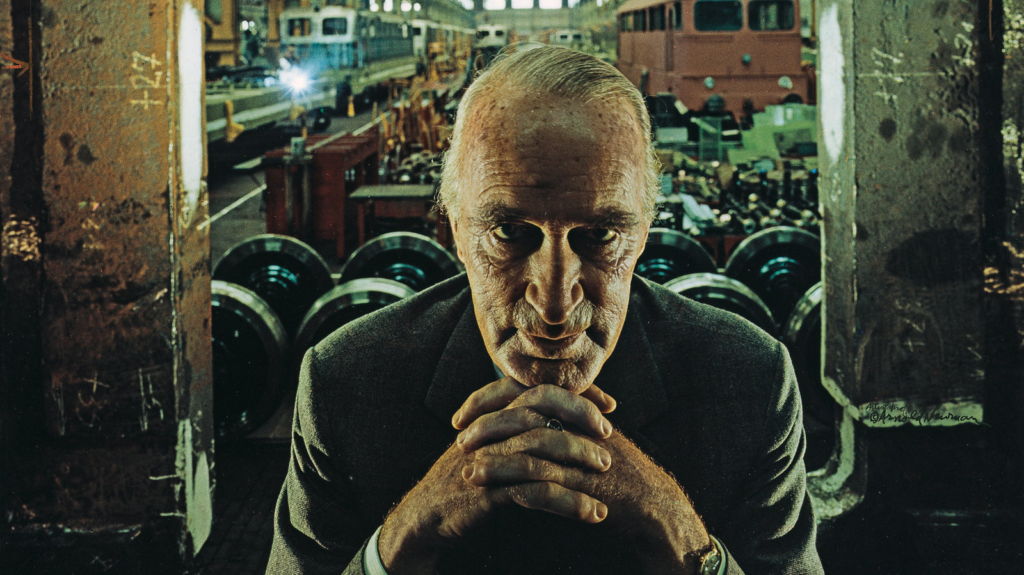Who is Arnold Newman?
Arnold Newman (1918-2006) was an American photographer known for his environmental portraits of artists and politicians. He was also known for his carefully composed abstract still-life images. With his method of portraiture, he placed his sitters in surroundings represented of their professions , aiming to capture the essence of the individuals life and their work. Arnold Newman is widely known for pioneering and popularizing environmental portraits.
About him
Arnold Newman was born March 3rd 1918, in New York City. He studied art under a scholarship at the University of Miami, Coral Gables, FL from 1936 to 1938. In June of 1941, Beaumont Newhall of the Museum of Modern Art and Alfred Stieglitz “discovered” him, and he was given an exhibit with Ben Rose at the A.D. Gallery in September. There he began working on experimental portraiture. He then returned home to Miami Beach, but once he was well established, he moved to New York in 1946 and opened his studio and became a member of the American Society of Magazine Photographers. Newman’s new approach to portraiture began its influence through key publications in America and abroad. Exhibits and purchases of his work by major museums quickly followed. In 1949, he married Augusta Rubenstein, and they had two sons, Eric, born 1950, and David, 1952. He died in New York City on June 6, 2006 and his wife died in 2009.
Who inspired him?
Arnold Newman stated that he was particularly inspired by Flemish painters. However, he also mentioned the work of Cubists including Picasso, who influenced the way Arnold Newman structured his photographs.
His work

This image shows us into the life of Pablo Picasso, who is the man in this photograph. Pablo Picasso is a famous artist, who painted and made art pieces. In this photograph he is surrounded by all his work, which suggests this is his studio. However, the rocking chair in this photograph also suggests that this is his living area and his home.
This image is in black and white, which most of Arnold Newman’s pictures were. This helped to add more contrast to the photo, because it had lots of light and dark tones throughout the photo. The black and white also helped to create more texture in the photograph, especially in Picasso’s art pieces and canvas painting. The viewpoint of this photo is Picasso, who is in the centre of the photo. Him being in the centre in the composition presents him as the viewpoint, as it is leading out eye towards him. The position Picasso is sat in on his chair, with him leaning forward, leaning on his arms and sat with his legs spread either side of the chair suggests that Picasso is not a very serious person and he has a sense of fun about him. However, Him leaning forward on his chair and leaning of his arms with him in the centre of the room suggests that he owns this room and is proud of everything in it. This photo has natural lighting coming from the side window, but also uses indoor lighting as the photo was taken indoors. This has low light sensitivity as the image is not grainy.

This is a famous photograph of Arnold Newman’s, which was published in The New York Times. This picture contains two people, who are Marylin Monroe and Carl Sandburg, who are pictured in their natural environment, and doing things, which are natural to them, like having an alcoholic drink.
This photo is in black and white, with lots of black and white tones like most of Arnold Newman’s photos. The layout of this photo is the two individuals in the centre of the photo, which then makes them the viewpoint of this photo. The background of this photo suggests that this is their living space or an environment that is natural to them, like a hotel, which they are in often. Marylin Monroe is a famous singer and Carl Sandburg is a famous poet, so him and Marylin tend to stay in hotels often, which is why this photo was set in a hotel room. Marylin Monroe and Carl Sandburg were in a relationship with each other, which makes this environment more natural to them as they are very often together. The photo was taken indoors, so we can interoperate that the lighting of the photo was not natural lighting and a flash was used, or indoor lighting.

The individual, who is the viewpoint in this photograph, is Alfried Krupp, who was an industrialist, who used slave labour. Arnold Newman at first refused to take his photo, as he did not agree with how he did things, but after some time Arnold Newman agreed to photograph him, because he saw this as an opportunity. Alfried Krupp hated this photo and wanted Arnold Newman to delete it, but he didn’t and instead used it as a way to share the unmoral things Alfried Krupp was doing.
The background of this image is Alfried Krupp’s industrial factory, so this environment was natural to him. This photo is one of the few portraits that Arnold Newman took, that wasn’t in black and white, but instead it has a green tint to it, which is caused by the lighting used, as this photo uses quite dim lighting. This makes the photo look more scary and sinister. The individual is posed leaning forward onto his hands, while glaring, which causes him to look really sinister. Arnold Newman used this pose to make Alfried Krupp look really sinister to the viewers, so they would know, that he was a sinister individual in every day life. This photo caused society to learn the real truth about Alfried Krupp and about his industrial business, and it was all because of how Arnold Newman positioned him, the lighting, the background and how he refused to delete the picture when Krupp wanted him to , but instead posted it in the New York Times.
